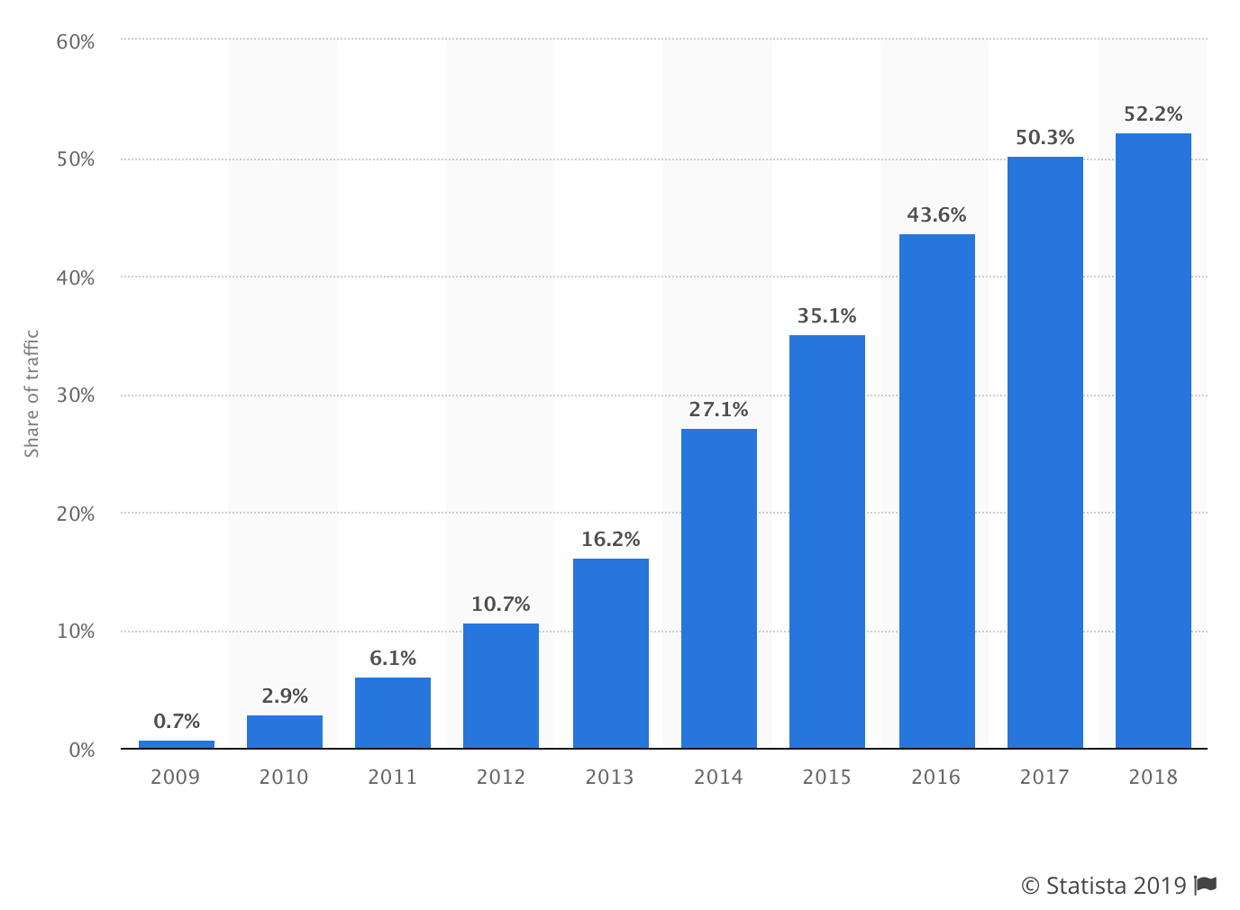Understanding Mobile Commerce and Buyers' Habits
Posted by Sarah Wai on Feb 12, 2019 8:00:00 AM

Mobile commerce is an important aspect of sales, and consumers utilize it constantly (peep the rise of Amazon and other big online retailers).
As of 2018, according to Statistica, worldwide mobile phone internet traffic as share of total global online traffic was 52.2%. This means that over 50% of all internet traffic globally is from mobile devices. You can see in the following chart how dramatically that number has increased over the last decade and that it continues to climb:

Add onto this stack of information the fact that B2C mobile commerce sales in the U.S. reached 197.38 billion dollars in 2018. In 2012 (just six years before), it was at a mere 34.78 billion dollars.
B2B mobile commerce sales in the U.S. are approximately 13% of all B2B mobile commerce sales, and in 2017 those sales equaled 889 billion dollars.
Imagine having a piece of that number.
A mobile-optimized e-commerce website is an investment, but it's worthwhile and a powerful tool for businesses if created and marketed properly.
Let's look at some facts to build our case.
Evaluating Mobile Users and Their Buying Habits
The only way for anyone to understand mobile users and their buying habits is to assess what has happened in the past. Theories and predictions are great and can be beneficial, but facts speak volumes. Here are a few key demographics to pay attention to when it comes to mobile commerce:
Millennials
You do NOT want to pass by this demographic. They are the future, and they are buying NOW. Take it from me- a modern day Millennial. I do all of my research online before I buy anything online or in brick-and-mortar stores, but honestly, probably 90% of my shopping is online.
- Over 57% of Millennial shoppers turn to mobile to research products, compare prices, and make their final purchase
- Millennials make 54% of purchases online
- 63% of Millennials complete transactions on their smartphones
- 83% of Millennials are not concerned about security while shopping online
- They spend roughly $600 billion a year as a whole
- 60% of them prefer to buy generic brands over name brand goods (surprising, huh?)
- They desire a seamless user experience, and with their shorter attention spans (thank you, technological advances) they are far more likely to leave your site if they don't get it. Am I bashing Millennials by saying this? Not at all. Remember, I am one. These are the facts.
Omnichannel Shoppers

To omnichannel shoppers, the internet is their source of inspiration. They are commonly found researching items online, and then actually going to a physical store to make the purchase. They are those who spend hours browsing all the things they want on Pinterest in their spare time. They picture their lives through the lens of endless possibilities. They are also a demographic you don't want to take for granted. Here's why:
- Businesses that adopt omni-channel strategies achieve 91% greater year-over-year customer retention rates compared to business that don’t, according to a survey conducted by Aspect Software in 2014.
- 15 years ago the average consumer typically used two touch-points when buying an item and only 7% regularly used more than four. Today consumers use an average of almost six touch-points with nearly 50% regularly using more than four. (Marketing Week)
- Said to be "the emerging retail reality" by Google, the omnichannel shopper makes purchase decisions on the go
Mobile users can do any task and complete purchases just like desktop users will, provided its presented in a usable way. Mobile users are a tricky crowd; if your site is not easy to navigate and is wonky on their screens, they'll quickly look elsewhere.
Do you really want to risk losing that kind of business?
It's not just about making your site mobile-friendly anymore. It's about creating a positive mobile experience. This needs to start with a user-friendly, intuitive website that is adapting with current design and functionality trends. 
Risks Involved with Bad User Experiences
Have you ever found yourself going to a website on your mobile device to do a little research on a product, purchase something, or try to schedule an appointment, only to find that you can't do what you wanted from your phone? I know I have, and I know for a fact that every single time I left the site without doing anything further.
And honestly, every time I have had this happen I immediately discredited the company and mentally labeled them as "behind the times". Why would I get a product from someone who obviously isn't on top of things? Now this may not be everyone's line of thought, but it is certainly mine, and I can't be the ONLY person thinking this way.
But you don't need to take my opinion. Here are some facts:
- 58% of mobile shoppers abandon a transaction if the experience is not optimized for mobile
- 57% users say they won’t recommend a business with a poorly designed mobile site
These numbers will only increase with time. Don't allow yourself to be left behind!
The real question at the end of this is: Are you willing to adapt and take initiative for your business or will you idly stand by as technology and potential customers pass you by?
Written by Sarah Wai
Former Content, Email, and Social Media Marketing Specialist of Tribute Media. Bachelor of Science in Digital Communication Arts and Master in Business Administration.

